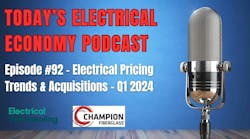Building permits show strong growth in September. Privately-owned housing units authorized by building permits in September were at a seasonally adjusted annual rate of 1,225,000, 6.3% above the revised August rate of 1,152,000 and 8.5% above the Sept. 2015 estimate of 1,129,000. Single-family authorizations in September were at a rate of 739,000, 0.4% above the revised August figure of 736,000. Authorizations of units in buildings with five units or more were at a rate of 449,000 in September.
ISM’s Purchasing Manager Index (PMI) shifts into growth mode in September. The September PMI registered 51.5%, an increase of 2.1 percentage points from the August reading of 49.4%, according to the Institute for Supply Management (ISM) Manufacturing Business Survey Committee. The increase reflected a more optimistic purchasing environment because it moved past the 50-point mark marking a growth environment.
Oil rig count slides in September. Baker Hughes, Houston, said the international rig count for September 2016 was 934, down three from the 937 counted in August 2016, and down 206 from the 1,140 counted in September 2015. The international offshore rig count for September 2016 was 221, down seven from the 228 counted in August 2016, and down 47 from the 268 counted in September 2015.
The average U.S. rig count for September 2016 was 509, up 28 from the 481 counted in August 2016, and down 339 from the 848 counted in September 2015.
Leading indicators drop slightly. The Conference Board Leading Economic Index (LEI) for the U.S. declined 0.2% in August to 124.1 (2010 = 100), following a 0.5% increase in July, and a 0.2% increase in June. “While the U.S. LEI declined in August, its trend still points to moderate economic growth in the months ahead,” said Ataman Ozyildirim, director of business cycles and growth research at The Conference Board. “Although strengths and weaknesses among the leading indicators are roughly balanced, positive contributions from the financial indicators were more than offset by weakening of nonfinancial indicators, such as leading indicators of labor markets, suggesting some risks to growth persist.”








